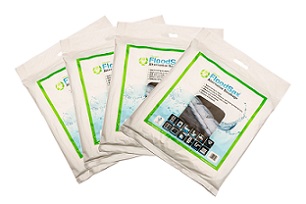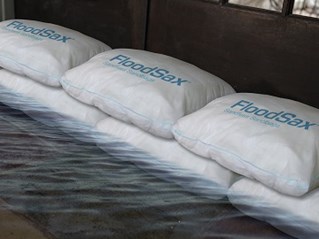FloodSax are a multi-purpose flood prevention device that will stop floodwater from getting into your home and soak up leaks, spills, drips and floods inside too.
FloodSax are vacuum-packed and are ultra thin with a large surface area so in their dry state can be put under leaking pipes, boilers, taps and sinks to absorb the water and prevent damage inside homes and businesses.
Outside they need to be immersed in water and will absorb 20 litres to expand and weigh around 20kg. They can then be built into a highly effective flood barrier with each row of FloodSax keeping out about 8 inches of water.
How to deploy FloodSax as a flood barrier
Open the cardboard box containing 4 packs of FloodSax. There are then 5 FloodSax in each pack. Take them out of the bag and remove them from the vacuum-wrapping. FloodSax look a bit like pillowcases or empty sandbags until they come into contact with water.



Fully immerse each FloodSax in water until it has fully expanded and the outer white cover goes tight. This can take up to 7 minutes and as the water is absorbed by the FloodSax keep replacing it until the FloodSax won’t absorb any more. You can use:
- A sink, large bucket or plastic box
- A wheelbarrow as you can activate the FloodSax and then wheel them to where they are needed
- The floodwater itself if time is short and flooding is imminent
Place the expanded FloodSax in tightly-packed layers to build a barrier outside your home, ensuring each row overlaps the joins on the one below in the same way that bricks do to be certain the wall is really solid.
Put a dry FloodSax inside the closed door to soak up any water that may seep through.



Flooding through sewage pipes can be a real problem so simply roll a dry FloodSax up and gently push it into the toilet where it will expand on contact with the water and seal the toilet.
FloodSax (like ordinary sandbags) should only be used for one flooding incident as they will become contaminated by filthy floodwater. They are largely biodegradable so can be put in the general waste for landfill.